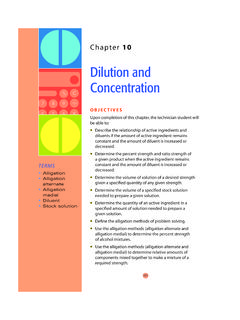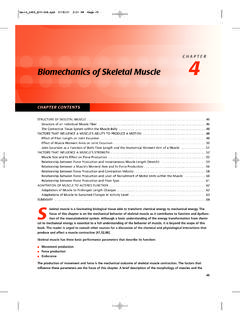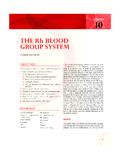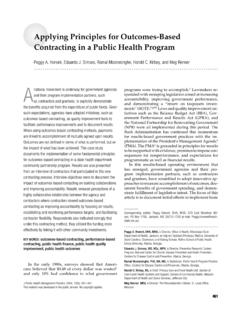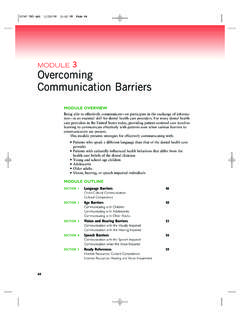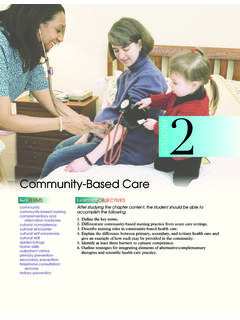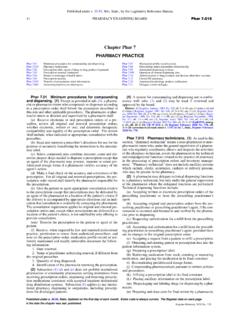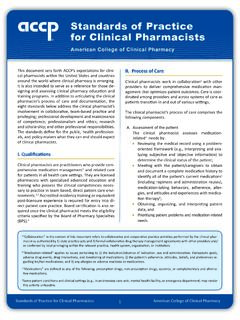Transcription of Ansel’s Pharmaceutical Dosage Forms and Drug Delivery …
1 Ansel s Pharmaceutical Dosage Forms and Drug Delivery SystemsNINTH EDITIONLoyd V. Allen, Jr., PhDProfessor and Chair EmeritusDepartment of Medicinal Chemistry and PharmaceuticsCollege of PharmacyUniversity of OklahomaEditor-in-ChiefInternational Journal of Pharmaceutical CompoundingNicholas G. Popovich, PhDProfessor and HeadDepartment of pharmacy AdministrationCollege of PharmacyUniversity of Illinois at ChicagoHoward C. Ansel, PhDProfessor and Dean EmeritusCollege of PharmacyThe University of i10/22/2009 9:53:56 ii10/22/2009 9:53:56 iii10/22/2009 9:53:59 PMiv PREFACEADDITIONAL RESOURCESA nsel s Pharmaceutical Dosage Forms and Drug Delivery Systems, Ninth Edition, includes additional resources for both instructors and students that are available on the book s companion Web site at adopting instructors will be given access to the following additional resources:PowerPoint slides.
2 STUDENTSS tudents who have purchased Ansel s Pharmaceutical Dosage Forms and Drug Delivery Systems, Ninth Edition, have access to the following additional resources:A quiz bank with more than 200 questions. In addition, purchasers of the text can access the searchable full text online by going to the Ansel s Pharmaceutical Dosage Forms and Drug Delivery Systems, Ninth Edition, Web site at See the inside front cover of this text for more details, including the passcode you will need to gain access to the Web OF THE SOAP FORMAT FOR CASE STUDIESaThe most commonly used documentation format for case studies is referred to by the mnemonic SOAP, which stands for Subjective information, Objective information, Assessment, and a SOAP note is begun, the following must be clearly defi ned.
3 What are the patient s most important problems that must be addressed and/or resolved now?What is the evidence that each problem exists? What are the therapeutic goals and options for each problem? The answer to each of these questions Forms the content of the assessment section of the SOAP note. Therefore, the assessment is written mentally before the actual SOAP note is begun. After the problems are defi ned, subjective and objective information needed to justify why those problems exist should be written fi rst paragraph begins with S: and contains subjective information, which is obtained from the patient interview. Examples of subjective information include patient provided information about disease symptoms, over-the-counter medications, drug allergy descriptions, and second paragraph begins with O: and contains objective information obtained by physically examining the patient, reviewing laboratory data, checking prescription records for doses and refi ll patterns, locating medication costs from a printed or online formulary, and so on.
4 Some information can be either subjective or objective, depending on how it is obtained. The most important thing to remember when composing the subjective and objective portions of notes is that only information pertaining directly to the assessment should be third paragraph begins with A: and contains the pharmacist s assessment of the patient s medical and pharmacologic problem or problems. If the subjective and objective paragraphs are writ-ten well, the problem should be obvious to the reader. Other types of information included in the assessment paragraph are the therapeutic goals and a brief discussion of the therapeutic fourth paragraph begins with either P: or R: and details either a plan (P) or a recommen-dation (R), whichever is more appropriate for the situation.
5 The plan should include individualized a Adapted with permission from O Sullivan TA, Wittkowsky AK. Clinical drug monitoring. In: Stein S, ed. Boh s pharmacy Practice Manual: A Guide to the Clinical Experience. 3rd Ed. Baltimore: Lippincott Williams & Wilkins, 2010; iv10/22/2009 9:54:00 PM PREFACE vinstructions (drug by generic name, dose, route, frequency, and, when applicable, duration of therapy). The exact dose and frequency should be identifi , the monitoring plan must be detailed, including specifi cally what should be measured ( , laboratory test, symptom), who should measure it (patient, caregiver, pharmacist), when and how frequently the measurement should be performed, and at what point changing therapy should be considered.
6 A backup plan for use in the event of therapeutic failure should also be noted here. Finally, instructions for the proper use of prescribed medication or medications should be included to enhance the therapeutic acknowledge with grateful appreciation the major contributions and foresight of Howard C. Ansel, the originator of this textbook, whose guidance and hard work over the years have signifi cantly con-tributed to the education of tens of thousands of pharmacists worldwide. Deep appreciation is given to Nicholas G. Popovich for his extensive contribution to this textbook on clinical pharmacy and phar-macy practice and for his unique ability to present the integrated approach used in this book.
7 Together, we extend our gratitude to the students and academic colleagues who have shared their thoughts with us on this revision; we hope that we have been successful in responding to their thoughtful sugges-tions. We also acknowledge with appreciation our colleagues in industry who have generously pro-vided scientifi c and technical information and updated the fi gures and photos for our gratefully acknowledge the following individuals who contributed to the development of this book through their critiques, reviews, and suggestions on the individual 15 (Parenterals): Mary Baker, PharmD, Medical Manager and Clinical Fellow, Global Medical Affairs, Hospira, Inc.
8 , Lake Forest, IL; David W. Newton, PhD, Professor, Department of Biopharmaceutical Sciences, Bernard J. Dunn School of pharmacy , Shenandoah University, Winchester, VA; Ms. Jane A. Gottlieb, RPh, pharmacy Department, Clarian Health, Indianapolis, IN; Ms. Hema Patel, Cleanroom Manager, Hospital pharmacy Services, University of Illinois Medical Center, Chicago, IL; and Daphne E. Smith, PharmD, Clinical Assistant Professor, University of Illinois at Chicago, College of pharmacy and Clinical Pharmacist, Ambulatory Care Services, Univer-sity of Illinois at Chicago, College of 16 (Biologics): Leslie Ann Briars, PharmD, Clinical Assistant Professor and Pediatric Clinical Pharmacist, Ambulatory Care pharmacy Services, University of Illinois at Chicago, College of pharmacy and Mary Ann Kliethermes, PharmD, Associate Professor and Vice Chair, Department of pharmacy Practice, Midwestern University Chicago, College of pharmacy , Downers Grove, 18 (Radiopharmaceuticals).
9 Dan Murphy, RPh, pharmacy Compliance Manager, Northeast Region, Nuclear pharmacy Services, CardinalHealth Nuclear pharmacy Services, West Hartford, CT; Peter Sposato, RPh, pharmacy Manager, CardinalHealth Nuclear pharmacy Services, Glastonbury, CT; and Lou Juliano, RPh, formerly Senior Vice President, Healthcare Supply Chain Services Pharmaceutical Segment, Cardinal Health Incorporated/Syncor International Corporation, Woodland Hills, 19 (Products of Biotechnology): Margaret , PharmD, FAPhA, Senior Manager, Practice Development and Research, American Pharmacists Association, Washington, DC; and Kaushik Bhatia, PharmD and Kathy Phan, PharmD, University of Illinois at Chicago, College of pharmacy , Class of to this edition are the individual and group exercises.
10 A number of former doctoral students at the Purdue University School of pharmacy and the University of Illinois at Chicago, College of pharmacy helped conceive them, and we sincerely appreciate their contributions to this book. Those who helped create these exercises were Vyto Damasius, PharmD; Elizabeth Choing, PharmD; Janet Lee, PharmD; Eric Haas, PharmD; Nicole Vanderhei, PharmD; Jenna Demy, PharmD; Laura Labbe, PharmD; Kelly Gregory, PharmD; Keith Gaetano, PharmD; Sean Musil, PharmD; Robert Beckett, PharmD; Donna Prole, PharmD; Crystal Chang, PharmD; Jankhana Bhagwakar, PharmD; Ashwini Pai, PharmD; Shital Patel, PharmD; Arti Phatak, PharmD; Anthony Tardi, PharmD; Erin O Neill, PharmD; Calea Driscoll, PharmD; Edward Song, PharmD; Phyllis Lin, PharmD; John Lee, PharmD; Lulu Jin, PharmD.

